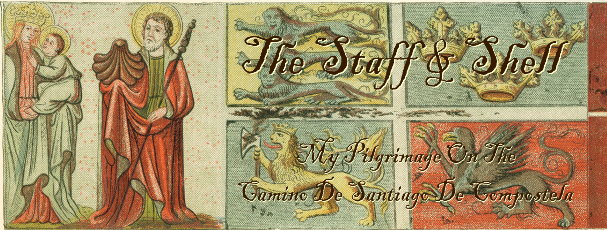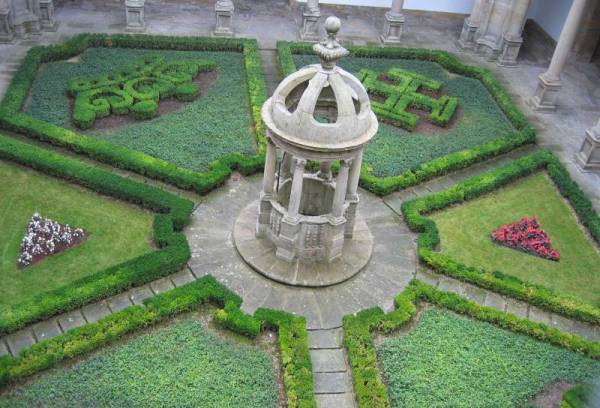 WHAT’S HAPPENING NOW
WHAT’S HAPPENING NOWTowards the end of the middle Ages the number of pilgrims traveling to Santiago began to decline but it never stopped, and these days it is definitely “back live”. During 2004, over 190,000 pilgrims walked or cycled some part of the road. However, it is no longer just the religious pilgrimage it once was.
The pilgrimage to Santiago is based on Catholic doctrine regarding sin, its remission and salvation. But today those religious elements share the stage with transcendental meditation, a physical stress test, a place to grieve, a journey of spiritual awakening, and a unique vacation.
Each day’s journey is like a field trip through a continuous museum. You cross two-thousand-year-old bridges that were built by the Romans. You sit down to lunch in the reconstruction of a five-thousand-year-old Iron Age hut. You are in constant contact with the great art and architecture of the Middle Ages.
For many people making the pilgrimage to Santiago is one of the most important undertakings of their lives. It gives them a sense of community in a society that goes back for thousands of years and includes everyone from Saint Francis of Assisi to Shirley MacLaine.
You may be alone when you start your trip but you will always be with someone at the end. Friendships are formed that cut across normal boundaries of age, class, and nationality. Becoming part of a larger community is an essential aspect of the pilgrimage. And working together to get through the challenges of the trip gives everyone a heightened sense of generosity.
The road is also unusual because it is so direct. Everything—the road, the setting sun, the stars—all appear to be going in the same direction. The pilgrim is literally “shown the way”.
Pilgrims experience a powerful feeling of being guided toward a goal, of having a sense of direction, and of knowing where one is going that is not so clear in daily life. Each day is an act of accomplishment toward a stated goal in which everything seems to be going the pilgrim’s way.
Most of the pilgrims are urban, well-educated members of the middle-class and they follow routes that are well marked with yellow arrows or scallop shells. In addition, there are signs that explain the importance of various historical sites.
Central to pilgrimage are the concepts of sin and the weight of one’s soul at death, eternal salvation and damnation. In order to save your soul from the tortures of hell, the Church suggested things that would lighten a soul weighed down by sin and making a pilgrimage was always on the list.
 PASSPORT PLEASE
PASSPORT PLEASEPilgrims on the road to Santiago are easily recognized. Almost every pilgrim can be identified by the scallop shell around his or her neck or attached to their backpack. The pack itself is also a signal and so is their walking stick.
For some pilgrims the backpack is a symbol of the baggage one carries through life— the lighter your pack the more unnecessary mental and physical baggage you have been able to discard.
The scallop shell is associated with Saint James, but also with the legend of Venus and rebirth. It is meant to remind pilgrims of their spiritual reawakening.
On a gastronomic note, it appears that pilgrims returning from Santiago to France brought with them the inspiration for coquilles Saint- Jacques—a dish of scallops in a cream sauce that is served in a scallop shell.
Pilgrims also carry a credential—a passport that is stamped each day. The stamp indicates a pilgrim’s progress or in some cases the lack thereof.
As part of man’s desire to make life as annoying as possible travelers on the road have developed their own totally unofficial criteria for authenticity. To make the trip on foot is the most “authentic”—the real stuff.
To make it on a bike is “semi-authentic”. Spanish walkers call people who use bicycles “decaffeinated pilgrims”.
To walk but have a support vehicle is not “authentic” but might still be accepted—depending on the circumstances.
Make the trip in a bus or a car and you’re off the team. Many pilgrims also believe that “authenticity” requires at least a month on the road. Of course, none of these standards existed in the Middle Ages—you made the trip and that was it.
 UP AT THE PASS
UP AT THE PASSAt 3,500 feet above sea level, the hill town of Cebreiro is the last great physical challenge for most pilgrims on their way to Santiago. For hundreds of years a Roman way station at the top guarded this mountain pass. And until the 16th century Cebreiro was one of the only passages into the Northwest of Spain.
In the year 836, a Benedictine monastery was established and it cared for pilgrims for over a thousand years. During the 11th century a rest stop for pilgrims on their way to Santiago was set up here and it is still in use.
In the 12th century the church of Santa Maria was built nearby. It contains a sacred chalice that commemorates a 15th century Eucharistic miracle.
The legend states that the Holy Grail from which Christ drank wine during the Last Supper was hidden in Cerbreiro. A priest who had his doubts about the validity of the story was using the cup for the Eucharist.
A massive snowstorm had been raging outside and only a single peasant had climbed the mountain to hear the mass. The priest began to criticize the man for coming through the storm when suddenly the bread and wine turned to flesh and blood. The priest saw the error of his ways.
The remnants of the miracle were placed in a silver container that was donated by Queen Isabel—the same Isabel who had the foresight to put up the money for the voyages of Christopher Columbus.
Cebreiro also has a reconstructed palloza — a type of oval stone house with a thatched roof that was used by the Iron Age tribes who occupied the area before the Romans arrived.
Santiago is less than a hundred miles from Cebreiro—a distance that will be covered in less than a week. The end of the physical trip is near, but for many the spiritual journey is just about to
begin.






























OUCH!! Your pack is too heavy - almost 2kg - and too large for el camino. It is designed and manufactured for mountain backpackers, with all the equipment one would need when camping out in the mountains. At most you will be carrying 'soft' contens - clothing and toiletries. Mountain backpackers rule of thumb is that your fully packed backpack should weigh around 10 - 15% of your body weight. With a 2kg backpack you will start off at a disadvantage.
ReplyDeleteTry the GoLite or the Gozamer Gear Murmur - both weigh under 600gr.
If you have an ALTUS raincape (with a great hunchback feature for your backpack) you won't need the backpack cover or a poncho. Available at www.barrabes.com They do prompt deliveries to the US.
Travel light peregrino - shed material weight and the mind will be light too!
Buen Camino,
Sil